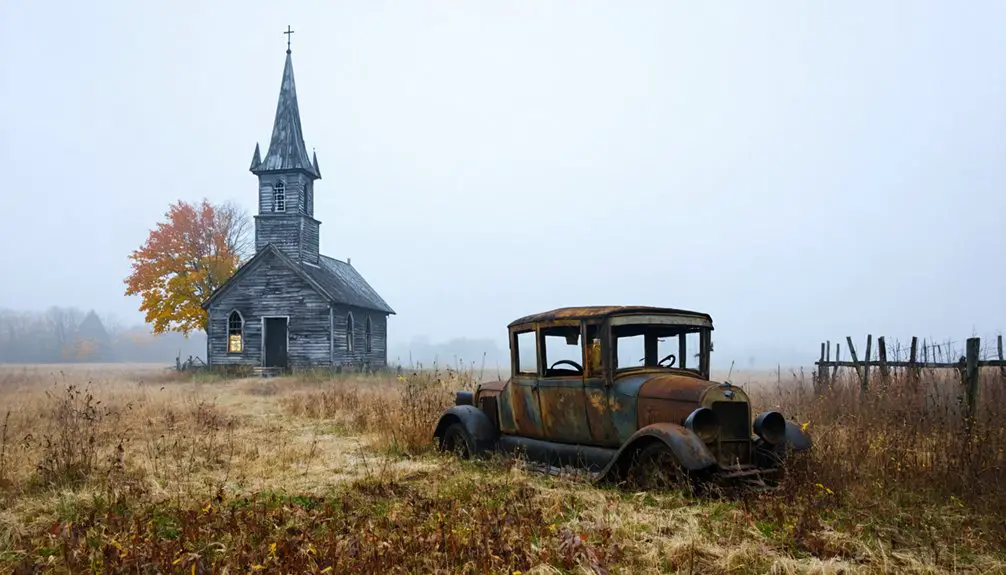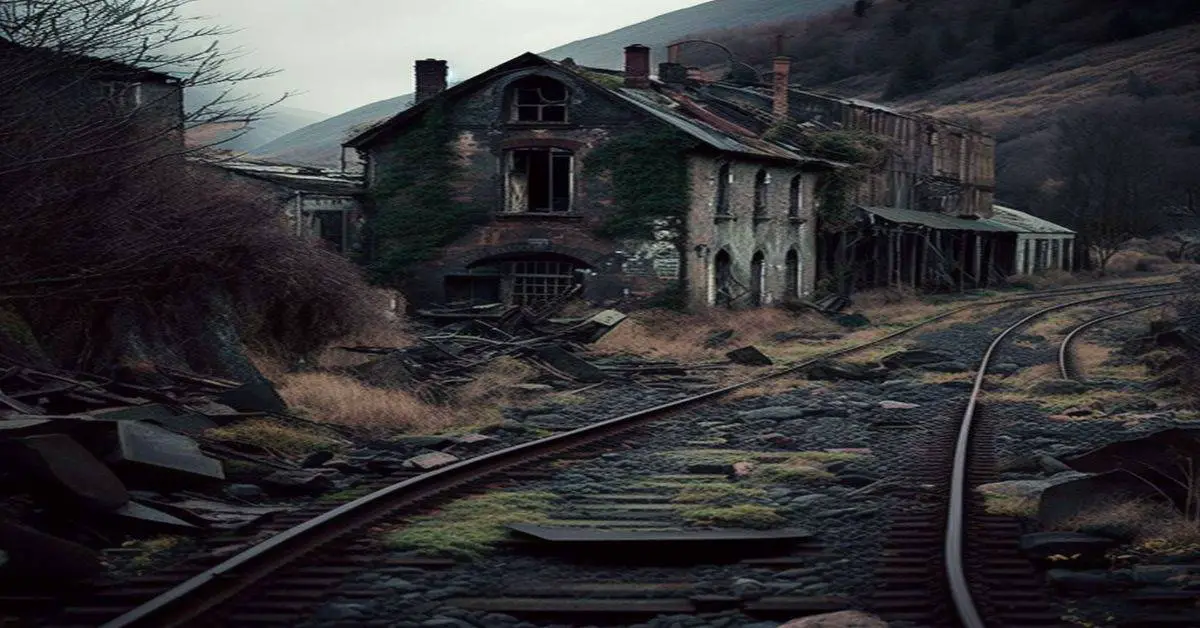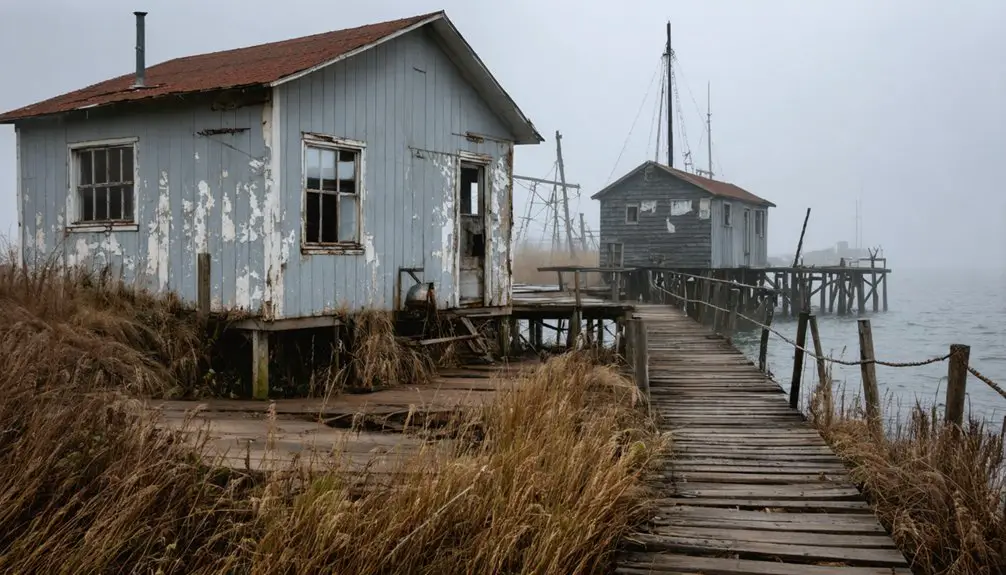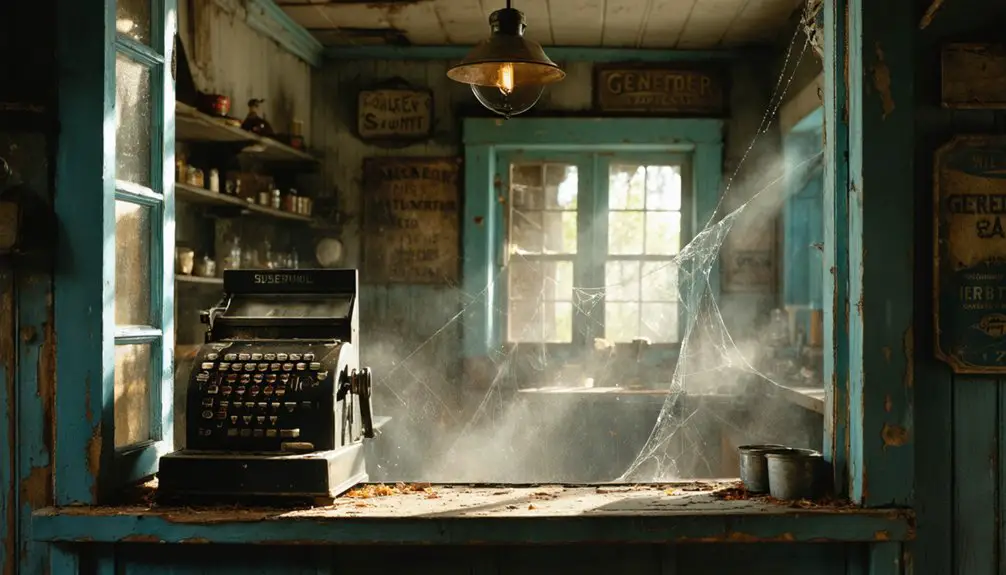You’ll find Nya Upsala’s remains near present-day Merton, Wisconsin, where Gustaf Unonius established the state’s first Swedish-American settlement in 1841. The pioneering community built log cabins, cleared dense forest, and created a parish that served as their cultural hub. Despite the settlers’ determination and community spirit, poor soil conditions and harsh frontier life led to the settlement’s abandonment. The site’s untold stories reveal Wisconsin’s rich immigration heritage.
Key Takeaways
- Nya Upsala was Wisconsin’s first Swedish-American settlement, established in 1841 near present-day Merton by Gustaf Unonius and fellow immigrants.
- Poor soil conditions and harsh wilderness challenges ultimately led to the settlement’s failure despite a decade of perseverance.
- The settlement featured a log cabin parish built in 1848, which served as both spiritual center and community gathering place.
- Settlers abandoned their vision of creating a Swedish cultural center due to economic hardships and agricultural difficulties.
- Though the physical settlement disappeared, it sparked Wisconsin’s first major wave of Scandinavian immigration through Unonius’s published letters.
The Swedish Vision of Gustaf Unonius
While studying at Uppsala University in the early 1830s, Gustaf Unonius developed a vision that would later shape Wisconsin’s first Swedish-American settlement.
After completing his law degree in 1833, he encountered experiences that fueled his Swedish aspirations, including working with cholera victims in 1834, which deepened his commitment to community service.
Unonius’ vision culminated in 1841 when he led a group of Swedish immigrants to establish Nya Uppsala, also known as the Pine Lake Settlement, near present-day Merton, Wisconsin.
You’ll find his influence reflected in how he structured the settlement, combining Swedish heritage with frontier opportunity. His frequent letters to Scandinavian newspapers helped attract more immigrants to the region.
He named the community after his alma mater, creating a symbolic bridge between old and new worlds while establishing a model for future Swedish-American colonies. After establishing the settlement, he attended Nashotah Theological Seminary and became an Episcopal clergyman.
Life on the Pine Lake Frontier
As you stand at Pine Lake’s eastern shore where Swedish settlers once built their log cabins, you’ll find traces of their challenging frontier existence marked by isolated homesteads carved from dense forest.
You’d have watched these pioneers construct rough shelters from local timber while learning to hunt game, fish the lake’s waters, and gather wild foods to supplement their limited farming yields.
Your daily life would’ve involved constant work – felling trees, clearing land, maintaining shelter, and making long trips to distant settlements for essential supplies they couldn’t produce themselves.
The Blue Mound Territorial Road provided the only major route connecting the isolated settlement to other communities in 1836.
Led by pioneer Gustav Unonius, the settlement initially aimed to establish a cultural center for Swedish immigrants but struggled due to poor soil conditions.
Daily Pioneer Survival Challenges
Life on the Pine Lake frontier presented Swedish settlers with unrelenting daily challenges that tested their resilience and resourcefulness.
You’d find pioneer ingenuity at work as settlers crafted makeshift furniture from hollow oak stumps and turned trunks into tables. Their survival tactics included digging cellars beneath floorboards to preserve food and trading surplus pigs with neighbors for essential supplies.
The stony lakeshore soil forced them to rely heavily on wild game and foraging, while costly flour and potatoes had to be hauled in from distant markets. They’d battle muddy roads and exhausted oxen teams during multi-day supply runs to Milwaukee. The unproductive soil ultimately contributed to the settlement’s eventual failure. Under the guidance of Gustaf Unonius, the settlers persevered through these hardships for over a decade.
When money ran short, they’d sell personal silver to survive, demonstrating how precarious life remained in this harsh Wisconsin wilderness.
Building Homes From Scratch
When Swedish settlers staked their claims along Pine Lake’s eastern shore in the 1840s, they’d face the intimidating task of building homes from scratch in Wisconsin’s dense frontier forests.
You’d need to start by clearing your land and sourcing local pine timber using basic hand tools. While constructing your permanent home, you might live in a temporary shanty or with neighboring settlers who’d already established themselves. Like the successful Western Emigration Company promotions, word spread about the promising opportunities in the region.
Log construction demanded intense physical labor and community cooperation. You’d work alongside fellow immigrants during the warmer months, sharing resources and expertise during cabin-raising events. The hardy settlers often utilized nearby tote roads to transport their building supplies.
Your home’s foundation would rest directly on cleared ground or stone footings, topped with hand-split shingles or thatch roofing. The harsh northern winters made it vital to build sturdy, well-insulated structures near water sources and transportation routes.
Gathering Food and Supplies
The daily challenge of securing food and supplies tested Pine Lake’s Swedish settlers, who arrived with limited cash reserves of around $200. You’d find them making difficult trips to Milwaukee through muddy roads with ox-drawn wagons, often taking multiple days to acquire essentials like stoves and building materials.
For food preservation, they’d dig basic root cellars into their cabin floors, covering the holes with boards to store perishables. Local supply trade became essential, with nearby settlers providing pork, flour, and potatoes. Under the leadership of Gustaf Unonius, the settlers worked to establish a cultural center for Swedish immigrants. The settlers maintained peaceful coexistence with the local Potawatomi Indians during their time at Pine Lake.
You’d see them gathering sawmill planks from Oconomowoc while relying on hunting and foraging to supplement their meals. The stony, poor-quality soil made farming nearly impossible, forcing them to depend heavily on bartering with neighbors and regional merchants for survival.
Cultural Heritage and Community Bonds
At Pine Lake’s Swedish parish, you’ll find evidence of how closely-knit immigrant families maintained their cultural identity through regular worship services and community gatherings in their log cabin church.
You can trace how these settlers wove together religious traditions from Uppsala with frontier practicalities, creating a distinctive Swedish-American cultural fabric through shared celebrations and parish activities.
The bonds formed during house-raisings, religious services, and community festivals helped the settlers preserve their Swedish heritage while adapting to Wisconsin frontier life.
Swedish Parish Life Activities
Established in the early 1840s near Pine Lake, the Scandinavian Parish at New Upsala quickly became a vibrant center of Swedish immigrant life under the leadership of founder Gustaf Unonius.
You’d find settlers gathering regularly for Sunday services, first in a simple schoolhouse in Summit before the construction of their own church building. Parish gatherings weren’t just about worship – they provided essential social connections for dispersed frontier families.
The parish’s community rituals, from baptisms to funerals, strengthened cultural bonds while helping immigrants adapt to their new home.
Educational activities centered around the church, including plans for a school and the founding of Nashotah Episcopal Seminary.
Through these shared experiences, you’d witness how the parish preserved Swedish traditions while fostering resilience in Wisconsin’s challenging frontier environment.
Cultural Identity Through Gatherings
Building upon their strong Swedish heritage, New Upsala’s settlers fostered cultural identity through regular gatherings that united nobles, merchants, military officers, and tradesmen in shared traditions.
You’d find these immigrant gatherings centered around the parish log cabin, built in 1848, where they held religious services and community events essential for cultural preservation.
Despite facing harsh winters and poor farming conditions, settlers maintained their bonds through storytelling, music, and traditional customs.
They’d connect with their homeland through letters and memoirs that circulated in Swedish newspapers, creating a vibrant transatlantic exchange.
The nearby Nashotah House seminary provided spiritual leadership, while the diverse socioeconomic backgrounds of settlers enriched their cultural celebrations.
Through these gatherings, they created a distinctive Swedish-American identity that bridged old-world aristocratic customs with frontier life.
Frontier Community Social Bonds
While Gustaf Unonius envisioned New Upsala as an intellectual and cultural center, the frontier settlement’s survival hinged on robust social bonds and mutual aid.
You’ll find that community resilience emerged through intensive cooperation, as settlers faced harsh frontier conditions with limited external support.
- Large-scale community projects, like house raisings, brought together 20+ settlers who’d work collectively while strengthening social connections.
- Families pooled their diverse skills and resources, creating informal local markets to trade essentials like pigs, flour, and potatoes.
- The log cabin parish served as both a spiritual anchor and social hub, where shared religious traditions reinforced cultural identity.
- Mutual support manifested through practical cooperation, from building food storage facilities to sharing tools and labor, ensuring collective survival in Wisconsin’s challenging environment.
Challenges of Early Settlement
As settlers arrived at the east shore of Pine Lake to establish Nya Upsala, they encountered a series of intimidating obstacles that would ultimately doom their settlement efforts.
You’ll find the environmental challenges were severe – unproductive soil made farming nearly impossible, while the stony lakeshore limited agricultural options.
The settlement hardships extended beyond nature’s constraints. You’d have struggled with the crude infrastructure of basic log cabins, primitive food storage in floor cellars, and the arduous two-and-a-half-day journey to Milwaukee for supplies.
Life in Nya Upsala meant primitive shelters, underground food storage, and grueling trips to Milwaukee for basic necessities.
The muddy roads often became impassable, especially after rain, isolating the community from essential resources.
When coupled with harsh Wisconsin winters and dwindling finances that forced settlers to sell their silver valuables, these challenges proved insurmountable for the fledgling settlement.
Religious and Social Activities
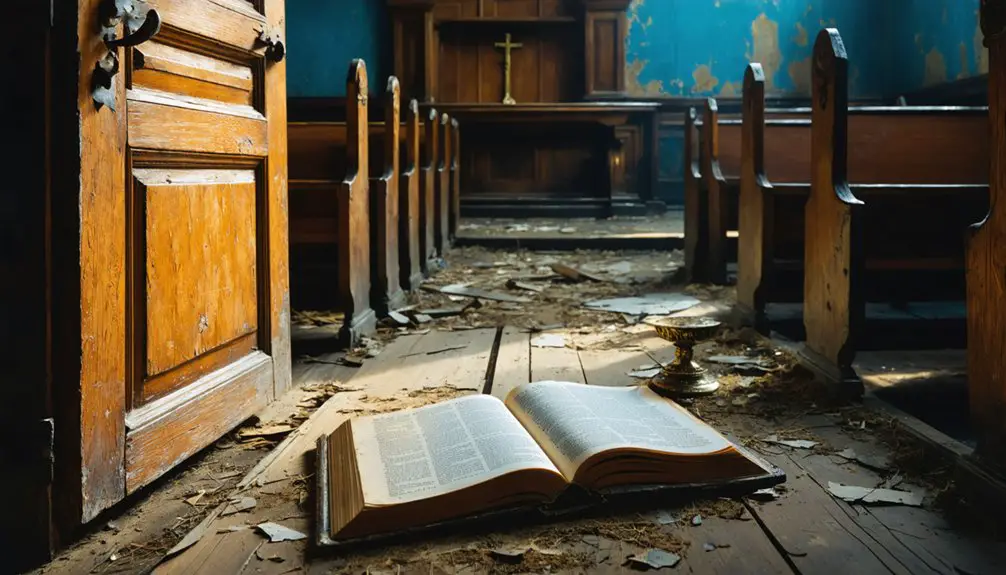
Despite the harsh physical challenges, religious and social activities formed the heart of Nya Upsala‘s community life. Under Gustaf Unonius’s leadership, the settlement built a log cabin church by 1848, establishing a vibrant Scandinavian parish.
You’d find the church serving as both a spiritual center and a hub for preserving Swedish culture, with plans to incorporate a school for the younger generation.
- Sunday services brought settlers together weekly for worship and social bonding
- House raisings combined practical work with feasting and celebration
- Community members shared resources, from farm goods to labor
- Religious gatherings often included educational components to maintain Swedish heritage
The settlement’s diverse leadership of nobles, theologians, teachers, and military officers helped create what settlers called a “haven of rest” amid the Wisconsin frontier.
The Settlement’s Brief Timeline
When Gustaf Unonius founded Nya Upsala in October 1841, he envisioned creating a Swedish cultural and intellectual center on Wisconsin’s frontier.
The settlement timeline began with the construction of the first log cabin on Pine Lake’s east shore, aided by Wisconsin’s first Swedish settler, Friman. By 1842, you’d have seen the community taking shape with new families arriving, a parish being established, and the Holy Innocents cemetery being consecrated by Bishop Kemper.
Under Unonius’s early leadership, the settlement attracted Swedish intellectuals, nobles, and professionals. However, the colony’s promising start quickly unraveled due to poor soil conditions and farming difficulties.
What Remains Today

Today’s visitor to the original Nya Upsala site will find little evidence of the once-promising Swedish settlement. Located along Pine Lake’s eastern shore in modern-day Chenequa and Nashotah, Wisconsin, the area’s archaeological findings are minimal, with no standing structures remaining. Environmental changes and natural reclamation have obscured most traces of pioneer life.
- You’ll encounter stony, unproductive terrain that mirrors the challenging conditions faced by original settlers.
- The landscape has transformed into suburban developments, though Pine Lake remains a constant geographic marker.
- No official historical markers exist on-site, with most documentation preserved in external archives.
- Private property restrictions limit access to the original settlement plots, making field research challenging.
The site exists more as a historical reference point than a traditional ghost town destination, with most evidence preserved through archival records rather than physical remnants.
Legacy in Wisconsin’s Immigration Story
Although Nya Upsala‘s physical settlement didn’t endure, its influence on Wisconsin’s immigration patterns proved transformative. When Gustaf Unonius published his letters in Swedish newspapers in 1842, he sparked the first major wave of Scandinavian immigration to the Midwest.
You can trace how his vision of creating a Swedish cultural center, though short-lived, established a blueprint for future ethnic enclaves throughout Wisconsin.
The settlement’s greatest impact came through its diverse immigrant profile – attracting nobles, theologians, merchants, and military officers rather than just farmers.
While the colony’s farming challenges ultimately led to its decline, Unonius’s leadership in establishing the Scandinavian parish created a lasting foundation for Swedish religious and cultural institutions.
This spiritual infrastructure helped cement Wisconsin’s role as an important center for Scandinavian-American identity.
Frequently Asked Questions
What Other Swedish Immigrant Settlements Existed Near New Upsala at That Time?
You’ll find Swedish and Scandinavian heritage communities at Lake Koshkonong near Janesville, Manitowoc County, and Milwaukee’s urban areas, where cultural influences shaped these growing settlements throughout the mid-1800s.
Did Any Descendants of New Upsala’s Original Settlers Remain in Wisconsin?
You’ll find descendant research challenging, as family history records show settlers scattered across Wisconsin after leaving the Pine Lake area, though some likely integrated into nearby Swedish-American communities around Nashotah House.
What Specific Crops Did the Settlers Attempt to Grow?
Like seeds scattered in harsh winds, you’ll find the settlers attempted potato farming and wheat cultivation, though records don’t detail their crop rotation beyond mentions of garden vegetables and possible rye.
Were There Any Conflicts Between Swedish Settlers and Native American Tribes?
You’ll find limited evidence of direct conflicts between Swedish settlers and Native tribes in Wisconsin, as most settler relations occurred after tribal relocations, though some peaceful cultural exchanges likely happened near reservations.
How Did Winter Weather Conditions Affect the Settlement’s Development?
You’ll find that winter hardships devastated early settlement efforts, as brutal cold shortened growing seasons, isolated communities, and demanded weather adaptations like root cellars and makeshift shelters for basic survival.
References
- https://en.wikipedia.org/wiki/New_Upsala
- https://sahswi.org/wp-content/uploads/2020/08/first-swedish-settlers-in-wisconsin-1.pdf
- https://sahswi.org/new-upsala-stories/
- https://www.wchsmn.org/timeline/
- https://en-academic.com/dic.nsf/enwiki/11813990
- https://en.wikipedia.org/wiki/Gustaf_Unonius
- https://www.wisconsinhistory.org/Records/Article/CS13898
- https://collections.carli.illinois.edu/digital/api/collection/npu_sahq/id/6385/download
- https://sahswi.org/gustaf-unonius-and-new-upsala/
- https://anglicanhistory.org/nashotah/unonius/index.html
